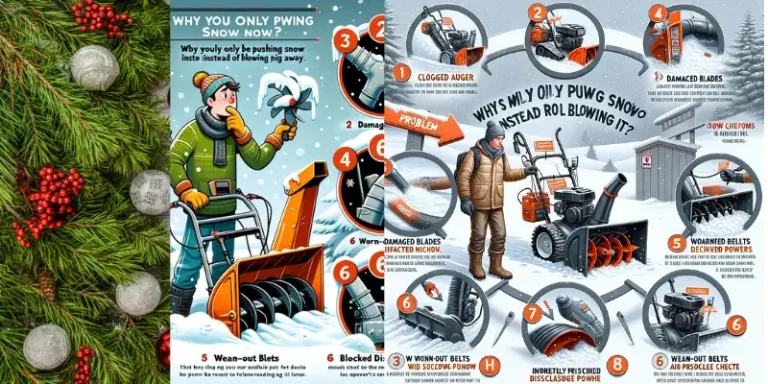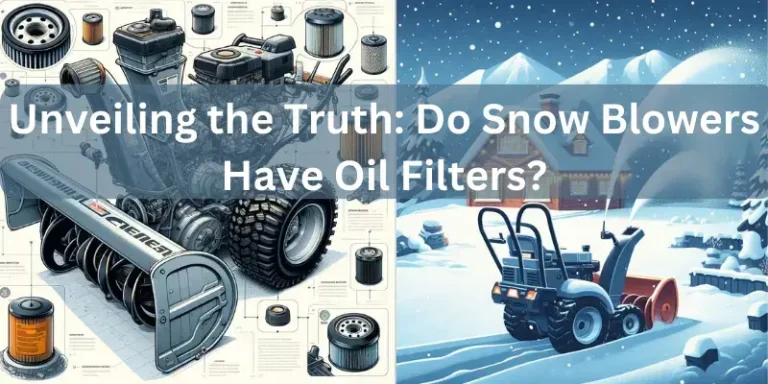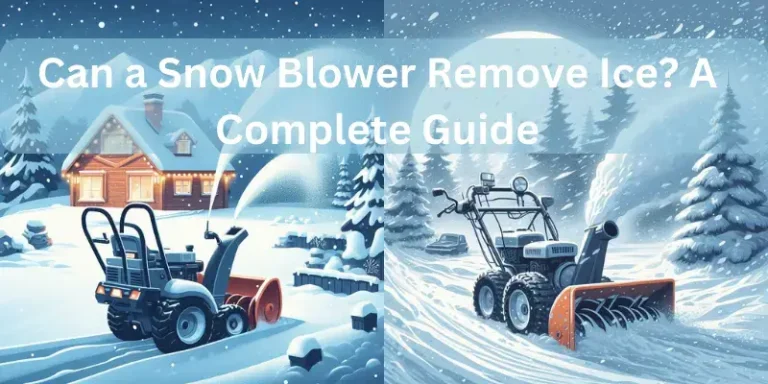Stay Dry and Efficient: Tips for Operating a Snow Blower in Wet Conditions
As winter is approaching, people start doing maintenance of their Snow Blowers, and finding answers related to maintenance and servicing of Snowblower and one of the common question is “Operating a Snow Blower in Wet Conditions”
While operating a Snowblower, there are a few factors that can impact its efficiency and performance. One of these factors is the condition of the snow itself, particularly when it is wet and heavy.
Operating a snow blower in wet conditions requires special attention and strategy to ensure that it stays dry and functions smoothly.
In this blog post, I will provide you with useful tips and tricks for operating a snow blower in wet conditions, allowing you to clear the snow efficiently and effectively while keeping your equipment in optimal condition.
Prepare Your Snow Blower
It is essential to prepare your Snowblower before operating in wet conditions, it is vital to take the time to inspect and clean the machine thoroughly. There are few aspects you must look into before start working to clean your driveway and paths from snow:
Inspect and Clean Your Snow Blower
As snowblower is not used for the whole year so you need to inspect it before the snow is on your door. Remove the debris and clog by washing and deep cleaning.
Check Oil and Fuel Level
The oil is a lifeline for snowblower, before starting working in the season, check the oil level. It is best to change the old oil because it will not only enhance the performance of your machine but also increase the life of your snowblower engine.
Checking and Replacing Damage Parts
To prevent any unexpected breakdowns while operating your snow blower in wet conditions, it is recommended to replace any worn-out parts. Belts, spark plugs, and shear pins are common parts that may need replacement due to wear and tear. Taking the time to replace these components before facing wet conditions will guarantee that your snow blower functions optimally, reducing the chances of encountering any issues during operation.
Checking the Loose Nuts and Bolts
Similarly it is essential to ensure that all nuts, bolts are fully tightened because loose nuts and bolts create trouble especially when you are clearing snow in the wet condition. Due to vibrational force.
Remember that, before operating your snow blower in wet conditions, it is vital to follow these tips to ensure a smooth and efficient operation. Thoroughly inspect and clean the machine, check the oil and fuel levels, replace any worn-out parts, and tighten all the nuts, bolts, and fasteners. By taking these simple yet important steps, you can stay dry and efficient while tackling snow removal in wet conditions.
Choose the Right Snow Blower
Selection of Right Snow Blower is very important. If you choose the right snow blower you can easily work in wet conditions without any problem. There are a few steps which are very important when you are choosing a Snowblower. These are:
Step 1: Type and Size of Snow Blower:
Single-Stage vs. Two-Stage:
When it comes to Choosing the ideal snow blower for wet conditions, your first decision is whether to go for a single-stage or a two-stage snow blower. Single-stage snow blowers are typically lightweight and compact, for smaller areas. However, if you regularly contend with heavy, wet snow, a two-stage snow blower may prove more efficient.
Size of Your Property:
To ensure effective snow removal in wet conditions, you must consider the size of your property if you are living in mansions or you have a larger driveways, walkways, choose a snow blower with a wider cleaning path and higher throwing distance will save you both time and effort blower with a wider clearing path and a higher throwing distance will save you both time and effort.
Electric vs. Gas-Powered Considerations
Similarly, another important consideration is the electric and gas-powered option. It’s very simple, it depends upon the above written aspects i.e. size of your property. The right snowblower is very important in clearing snow in wet condition.
Step 2: Opt for a model with powerful augers
In the Second Step, Powerful augers are vital for effective snow blower operation in wet weather. Find the snowblower model with serrated augers to cut through ice and slush, ensuring better traction and machine effectiveness. Look for multiple stages in the auger system to handle heavy, dense, or icy accumulations. Adjustable speed control allows you to match power for various wet snow types, making your snow removal more efficient even in the wettest conditions.
Safety Measures and Equipment
Wear the Right Gear
To operate your snow blower safely in wet conditions, wear protective gear. Use goggles to protect your eyes, gloves to protect your hands, and sturdy, non-slip boots. Consider a helmet for added protection against falling debris and dress in waterproof layers to stay dry.
Clearing the Way
Before starting your snow blower in wet conditions, clear the area. Remove branches, rocks, and other obstacles that could damage the machine or pose risks. Check for loose items that could get caught in the snow blower’s auger, and watch for hidden obstacles like roots or uneven ground.
Be Aware of Hazards
When operating in wet conditions, watch out for hidden dangers. Look for buried objects like tree stumps and sprinkler heads. Be cautious of dips, bumps, and icy patches that can affect the snow blower’s balance. Avoid areas with hidden utilities like electrical wires and gas lines to ensure a safe snow removal process.
Techniques for Snow Blowing in Wet Conditions
In addition to following safety measures and preparing your snow blower, there are a few more tips to keep in mind when operating a snow blower in wet conditions.
Intake Height Adjustment
Lower the intake height of the snow blower to prevent clogging when dealing with heavy, dense wet snow.
Take It Slow
Operate the snow blower at a slower pace. Wet snow can be more challenging to remove, so patience and shorter passes are key to an efficient process.
Pre-Treat with Deicer
Consider using a snow melting agent or deicer before snow blowing to help break up and loosen the wet snow.
Maintenance Matters
Properly maintain your snow blower after each use in wet conditions. This includes cleaning off any remaining snow and debris, drying moisture, and inspecting for damage or worn-out parts. Regular maintenance ensures longevity and effectiveness.
By following these practical tips and techniques, you can efficiently and safely operate your snow blower in wet conditions, keeping yourself dry and getting the job done effectively.
Conclusion
In a nutshell, Snowblower is mostly operated in wet conditions as snow itself melts into water. You can use your snowblower in the wet condition but you have to follow some safety precautions. Similarly, selection of the right machine is also essential. I try to cover all the aspects to make your machine safe.
Additionally, a snow blower can get wet, but understanding your snow blower’s capabilities and following the right maintenance practices will help you navigate through the wet and snowy winter months. With the right snow blower type and proper care, you’ll have a reliable winter ally to ensure your driveways stay clear and accessible even when the snow gets wet and challenging.

About Naveed A Hashmi
In my childhood, I used to see my parents while working in the land, for these reasons today I have been serving the same as our own tradition and culture. I thus love to stay in it, because I want to learn something advanced and new so that I may improve my farm’s contour and help others with my experience.







